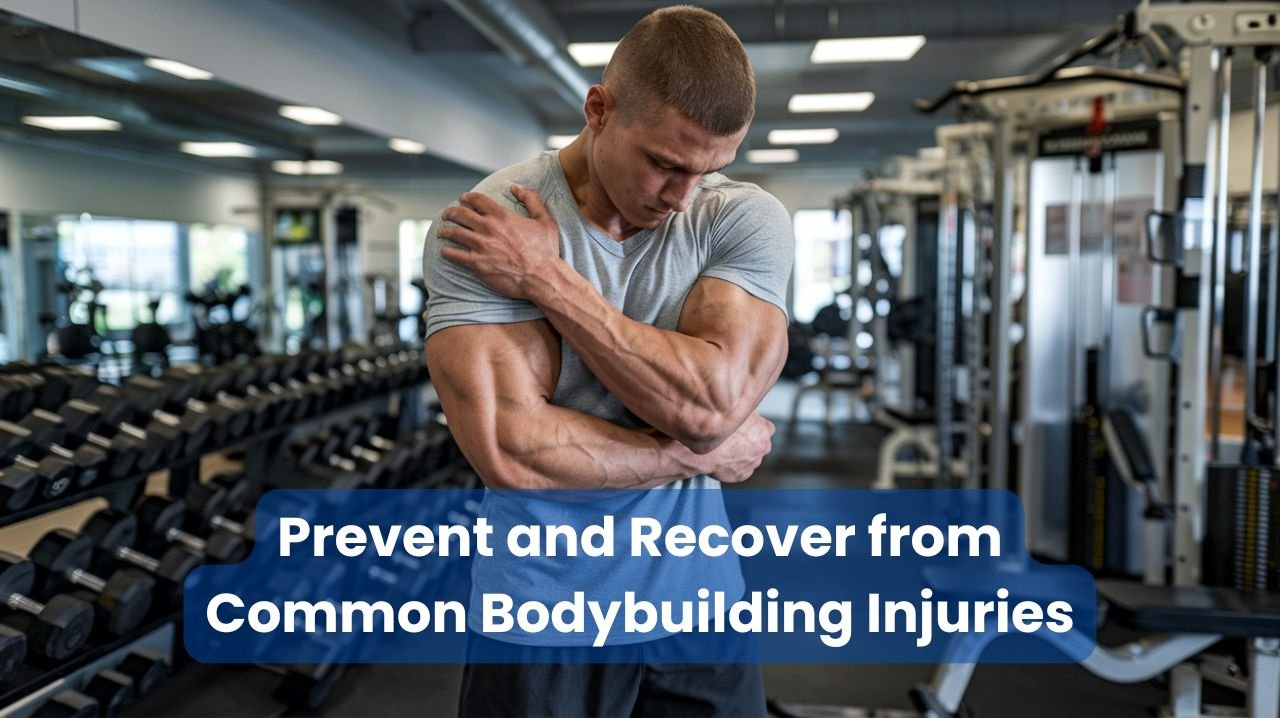How to Prevent and Recover from Common Bodybuilding Injuries
Bodybuilding is a rewarding pursuit that can lead to impressive physical transformations and improved overall health.
However, like any intense physical activity, it comes with the risk of injuries. Understanding how to prevent and recover from common bodybuilding injuries is crucial for anyone serious about their fitness journey.
This article explores the most frequent injuries bodybuilders face, how to avoid them, and the best ways to recover if they do occur.
👉 Boost in Focus and Energy to Help Increase Pumps and Performance
👉 Increase Gains, Promote Muscle Growth and Boost Energy
👉 Powerful Muscle Growth, Increased Blood Flow, and Enhanced Pumps
👉 Bulk-Up, Increase Gains, And Improve Recovery
Understanding Common Bodybuilding Injuries
Before diving into prevention and recovery strategies, it’s important to familiarize oneself with the injuries that bodybuilders most commonly encounter. These typically result from overtraining, improper form, or accidents during weightlifting.
Most Frequent Bodybuilding Injuries
- Shoulder impingement
- Rotator cuff tears
- Lower back strain
- Knee tendinitis
- Bicep tendon rupture
- Pectoral muscle tear
- Wrist sprains
Each of these injuries can significantly impede a bodybuilder’s progress and, in severe cases, lead to long-term complications. Therefore, prevention should always be the primary focus of any bodybuilding regimen.
Injury Prevention Strategies
Preventing injuries is far more efficient and less painful than recovering from them. By implementing the following strategies, bodybuilders can significantly reduce their risk of injury and maintain consistent progress in their training.
Proper Form and Technique
The cornerstone of injury prevention in bodybuilding is maintaining proper form and technique during exercises. This applies to all movements, from basic lifts like squats and deadlifts to more complex isolation exercises.
Tips for Maintaining Proper Form:
- Start with lighter weights to perfect form before progressing
- Use mirrors or record yourself to check form
- Engage a qualified personal trainer for form checks
- Focus on controlled movements rather than momentum
- Maintain proper breathing techniques throughout exercises
Warm-up and Cool-down Routines
Properly warming up before a workout and cooling down afterward are essential practices that many bodybuilders overlook. These routines prepare the body for intense activity and help it recover afterward.
Effective Warm-up Routine:
- 5-10 minutes of light cardio to increase blood flow
- Dynamic stretching to improve flexibility
- Light sets of the exercises planned for the workout
- Gradual increase in weight and intensity
Cool-down Routine:
- 5-10 minutes of low-intensity cardio
- Static stretching to improve flexibility and reduce muscle tension
- Foam rolling or self-massage to address tight muscles
Progressive Overload and Rest
Balancing progressive overload with adequate rest is crucial for preventing overuse injuries. While constantly pushing the limits is tempting, it’s important to give the body time to adapt and recover.
Implementing Progressive Overload Safely:
- Increase weight gradually (typically 2.5-5% per week)
- Boost volume (sets and reps) incrementally
- Improve form and range of motion before adding weight
- Vary exercises to prevent overuse of specific muscle groups
Importance of Rest:
- Allow at least one full rest day per week
- Ensure 48-72 hours of rest between training the same muscle group
- Prioritize sleep (7-9 hours per night) for optimal recovery
- Consider deload weeks every 6-8 weeks to prevent overtraining
Nutrition and Hydration
Proper nutrition and hydration play a vital role in injury prevention. A well-nourished and hydrated body is more resilient and recovers faster from the stresses of intense training.
Key Nutritional Considerations:
- Adequate protein intake (1.6-2.2 grams per kg of body weight)
- Balanced intake of carbohydrates and healthy fats
- Sufficient micronutrient intake, especially calcium and vitamin D for bone health
- Consideration of supplements like omega-3 fatty acids for joint health
Hydration Guidelines:
- Drink water throughout the day, not just during workouts
- Aim for clear or light yellow urine as an indicator of good hydration
- Consider electrolyte drinks for very intense or prolonged training sessions
Equipment and Environment Safety
The training environment and equipment used can significantly impact injury risk. Ensuring a safe workout space and using proper equipment is essential.
Safety Measures:
- Regularly inspect equipment for wear and tear
- Use appropriate safety gear (e.g., weightlifting belts, wrist wraps)
- Ensure adequate space around workout areas
- Keep floors clean and dry to prevent slips
- Use spotters for heavy lifts or when attempting new personal records
Recovery Strategies for Common Injuries
Despite best efforts in prevention, injuries can still occur. When they do, proper recovery is crucial to minimize downtime and prevent long-term complications.
RICE Method
The RICE method (Rest, Ice, Compression, Elevation) is a widely recognized first-aid approach for many acute injuries.
Implementing RICE:
- Rest: Avoid using the injured area to prevent further damage
- Ice: Apply ice for 15-20 minutes every 2-3 hours to reduce swelling
- Compression: Use elastic bandages to minimize swelling
- Elevation: Keep the injured area above heart level when possible
Physical Therapy and Rehabilitation
For more severe injuries, professional guidance through physical therapy is often necessary. A physical therapist can provide:
- Customized exercise plans to regain strength and flexibility
- Manual therapy techniques to promote healing
- Education on proper movement patterns to prevent re-injury
- Guidance on when it’s safe to return to regular training
Alternative Training Methods
While recovering from an injury, it’s important to maintain overall fitness without exacerbating the injury. This might involve:
- Cross-training with low-impact activities (e.g., swimming, cycling)
- Focusing on uninjured body parts
- Incorporating more flexibility and mobility work
- Using lighter weights with higher repetitions once cleared by a healthcare professional
Nutritional Support for Recovery
Proper nutrition can significantly accelerate the healing process. Key considerations include:
- Increased protein intake to support tissue repair
- Adequate calorie intake to support healing processes
- Foods rich in vitamin C, zinc, and omega-3 fatty acids to reduce inflammation
- Consideration of supplements like collagen or glucosamine for joint health
Mental Health and Recovery
The psychological aspect of injury recovery is often overlooked but crucial. Strategies to maintain mental health during recovery include:
- Setting realistic recovery goals
- Staying connected with the fitness community
- Practicing stress-reduction techniques like meditation or yoga
- Seeking support from a sports psychologist if struggling with the mental impact of injury
Common Bodybuilding Injuries and Their Specific Treatments
While general recovery principles apply to most injuries, some common bodybuilding injuries require specific approaches. Here’s a table outlining these injuries and their treatments:
| Injury | Symptoms | Treatment |
|---|---|---|
| Shoulder Impingement | Pain when lifting arm, especially overhead | Rest, ice, anti-inflammatory medication, physical therapy focusing on rotator cuff strengthening |
| Rotator Cuff Tear | Weakness in the shoulder, pain with certain movements | Rest, physical therapy, possible surgery for severe tears |
| Lower Back Strain | Pain and stiffness in the lower back | Rest, gentle stretching, core strengthening exercises, proper lifting technique education |
| Knee Tendinitis | Pain and swelling around the knee, especially during movement | Rest, ice, anti-inflammatory medication, physical therapy focusing on leg muscle balance |
| Bicep Tendon Rupture | Sudden pain in the upper arm, visible deformity | Immediate medical attention, often requires surgical repair |
| Pectoral Muscle Tear | Sharp pain in the chest or shoulder, visible deformity | Rest, ice, possible surgery for complete tears, followed by rehabilitation |
| Wrist Sprain | Pain, swelling, and limited mobility in the wrist | RICE method, wrist exercises, gradual return to lifting with proper form |
Preventing Re-injury
Once recovered from an injury, preventing its recurrence becomes a top priority. This involves:
- Gradually returning to full training intensity
- Continuing with exercises learned in physical therapy
- Paying extra attention to form in previously injured areas
- Regular assessments of muscle imbalances and addressing them promptly
- Considering the use of supportive gear (e.g., knee sleeves, wrist wraps) during heavy lifts
👉 Pack On Muscle Mass and Get Bigger and Stronger
👉 Burn Fat and Get Seriously Ripped
👉 Get Explosive Strength and Maximum Stamina
👉 Become A Gym Beast With Legal SARMs Alternatives
Conclusion
Bodybuilding can be an incredibly rewarding pursuit, but it comes with inherent risks. By understanding common injuries, implementing robust prevention strategies, and knowing how to recover effectively when injuries do occur, bodybuilders can minimize downtime and continue making progress towards their fitness goals.
Remember, listening to your body, prioritizing proper form over ego lifting, and seeking professional help when needed are key to a long and successful bodybuilding journey. Stay safe, train smart, and enjoy the process of building your best physique.







